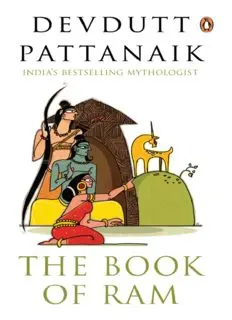
The Book of Ram PDF
Preview The Book of Ram
DEVDUTT PATTANAIK THE BOOK OF RAM Illustrations by the author PENGUIN BOOKS Contents Foreword Ramayana’s Protagonist Dashratha’s Son Vishwamitra’s Student Sita’s Husband Lakshman’s Brother Hanuman’s Master Ravana’s Enemy Ayodhya’s King Vishnu’s Incarnation Valmiki’s Inspiration Hindutva’s Icon A Prayer to Ram Bibliography Follow Penguin Copyright PENGUIN BOOKS THE BOOK OF RAM Devdutt Pattanaik is a medical doctor by education, a leadership consultant by profession and a mythologist by passion. He has written and lectured extensively on the nature of sacred stories, symbols and rituals and their relevance in modern times. His books with Penguin India include The Book of Ram, Myth=Mithya: Decoding Hindu Mythology, The Pregnant King, Jaya: An Illustrated Retelling of the Mahabharata, Sita: An Illustrated Retelling of the Ramayana, and the Devlok series of stories for children. Devdutt’s unconventional approach and engaging style are evident in his lectures, books and articles. To know more visit www.devdutt.com. By the same author Myth=Mithya: Decoding Hindu Mythology The Pregnant King Jaya: An Illustrated Retelling of the Mahabharata Sita: An Illustrated Retelling of the Ramayana Shikhandi and Other Tales They Don’t Tell You Foreword Any discussion of Ram today is dominated either by academic analysis or political debate. The former thrives on portraying Ram as a patriarchal poet’s fantasy. The latter either asserts Ram or rejects Ram, transforming him into a potent political lever either way. In the din of these discourses of power, the discourse of love is lost. One forgets that for hundreds of years, for millions of people, across history and geography, Ram’s name and Ram’s story has been a window to the divine. Ram’s name, the Ram-nam, is repeatedly chanted to tide over a crisis, for the name, Ram, when reversed becomes Mara, which means ‘die’. Ram is the opposite of Mara. Ram is life—with all its demands and desires and destinies. Ram’s calm repose in the face of all adversity, so evident in the Ramayana, has made him worthy of veneration, adoration and worship. Ram’s story has reached the masses not through erudite Sanskrit texts but through theatre, song and dance performed in local languages. All of these retellings of the Ramayana have their own twists and turns, their own symbolic outpouring, each one valid in their respective contexts. I write this book celebrating the Ram of the common man, the power of his name, the many retellings of his tale, drawing attention to the several layers of metaphors and meanings in the rituals and narratives, bringing forth my own creative insight, well aware that: Within infinite myths lies the Eternal Truth Who sees it all? Varuna has but a thousand eyes Indra, a hundred And I, only two Devdutt Pattanaik 1 Ramayana’s Protagonist O beloved son of Kaushalya, Dawn is about to break, O lion amongst men, Be pleased to open your eyes. And perform the duties of the day —From Venkatesa Suprabhatam by Prathi Vadhi Bhayangaram Annangaracharyar An upright hero The Ramayana, one of the most revered texts in Hinduism, tells the story of a prince called Ram. Dashratha, king of Ayodhya, had three wives but no children. So he conducted a yagna and invoked the gods who gave him a magic potion that was divided amongst his three queens. In time the queens gave birth to four sons. Ram was the eldest, born of the chief queen, Kaushalya, Bharata was the second, born to Dashratha’s favourite queen, Kaikeyi and Lakshman and Shatrughna were the twin sons of the third queen, Sumitra. Ram completed his early education under the tutelage of Rishi Vasishtha. He was then asked to defend Rishi Vishwamitra’s hermitage from attacks by the demons known as Rakshasas. Accordingly, Ram killed many Rakshasas in the time that he spent under Rishi Vishwamitra’s care including a female Rakshasa called Tadaka. Pleased with his actions, Vishwamitra taught him many potent magical chants that transformed ordinary arrows into potent missiles. Vishwamitra then took Ram to Mithila, capital of the kingdom of Videha. On the way, they came to the hermitage of Gautam, who had cursed his wife Ahalya to turn into stone because she had been unfaithful to him. Ram placed his foot on the stone that was Ahalya and she was instantly released from the curse, such was the purity of Ram’s character. At Mithila, Ram participated in the swayamvar being held by Janaka, the king of Videha. The young prince broke the mighty bow of Shiva that was in the king’s custody and by this display of strength, won the hand of Janaka’s daughter, Sita, in marriage. Sita was no ordinary woman. She had been ploughed out of the earth by Janaka who had then raised her as his own daughter. On Ram’s return to Ayodhya, Dashratha decided it was time to pass on the crown to Ram and retire from worldly life. Unfortunately, on the eve of Ram’s coronation, the maid, Manthara,
